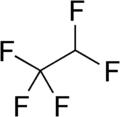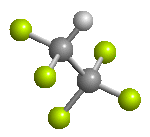R125
R125 (1,1,1,2,2-Pentafluoroethane), R-125, Freon 125, Khladon 125, Fc-125, Genetron HFC 125, Suva 125, is a refrigerant that has zero ozone depletion potential. Although it has zero ozone depletion potential, it has high global warming potential, reported by the United States Environmental Protection Agency (EPA) as 3450 times that of carbon dioxide. Pentafluoroethane in an zeotropic mixture with difluoromethane is known as R-410A, a common replacement for various chlorofluorocarbons (commonly known as Freon) in new refrigerant systems. Pentafluoroethane is also used as a fire suppression agent in fire suppression systems.
Uses
R125 can be used in clean agent fire suppression systems also referred to as Gaseous fire suppression Agent. It is generally used in situations where water from a fire sprinkler would damage expensive equipment or where water-based fire protection is impractical, such as museums, banks, clean rooms and hospitals . R125 does not deplete ozone (ODP 0) The R125 clean agent is stored in a pressurized container and introduced into the hazard as a gas. The agent is odorless, colorless, electrically non-conductive, non-corrosive, and leaves no residue. It is used in occupied enclosed areas that contain high-value assets.
HFC-125 (R125) suppresses fire by absorbing heat energy at its molecular level faster than the heat can be generated, so the fire cannot sustain itself. It also forms free radicals to chemically interfere with the chain reaction of the combustion process. This makes it a highly effective fire fighting agent that is safe for people and causes no damage to equipment.
The HFC-125 fire suppression agent is a non-ozone depleting replacement for Halon 1301. In addition, HFC-125 leaves no residue on valuable equipment after discharge.
HFC-125 is considered a Clean Agent and is therefore included in the National Fire Protection Association's 2001 - Standard for Clean Agent Fire Extinguishing Systems.
When introduced to the market HFC-125 was not considered safe for use in occupied spaces. The US EPA Significant New Alternative Policy (SNAP) listing reflected this. Following the introduction and acceptance of the PBPK model in the NFPA standard 2001 on Clean Agent Fire Extinguishing Systems 2004 Edition, the restriction was relaxed and now HFC-125 can be used in occupied hazards. Generally, class B (flammable liquid) hazards require concentrations that exceed the agent's no-observed-adverse-effect level (NOAEL) so extra precautions must be taken to avoid prolonged exposure to the agent.
Package & Transport
Package Size: 1000KG; 17 T
UN Number: 3220
Hazard Class: 2.2
Notice
1. Store in a cool, well-ventilated area of low
fire risk and out of direct sunlight.
2. Cylinders should be stored upright and firmly secured to
prevent falling or being knocked over. Valve protection caps and
valve cutlet threaded plugs must remain in place unless container is
secured with valve outlet piped to use point. Do not drag, slide or
roll cylinders.
3. Separate full containers from empty containers.
4. Avoid area where salt or other corrosive materials are present.
5.Avoid excessive inventory and storage time.
R125
  |
|
| Molecular formula | C2HF5 |
| Molar mass | 120.02 g/mol |
IUPAC Name
Identifiers
| CAS number | 354-33-6 |
| EC number | 206-557-8 |
| ChemSpider | 9256 |
| RTECS number | KI6365000 |
| ACX Number | X1016498-8 |
| DOT Number | UN 3220 |
| PubChem | 9633 |
| Jmol-3D images | Image 1 |
SMILES[show]
InChI[show]
Properties
| Appearance | Colorless gas |
| Density | 1.53 g/cm3 (liquid at -48.5 ℃) |
| Melting point | -103.0℃ (170.15 K) |
| Boiling point | -48.5℃ (224.65 K) |
| Vapour pressure | 9028 mmHg (20 ℃) |
| Solubility in water | Slightly soluble |

 English
English 中文简体
中文简体




 Arabic
Arabic  French
French  Italian
Italian  German
German  Japanese
Japanese  Korean
Korean  Portuguese
Portuguese  Russian
Russian  Spanish
Spanish 